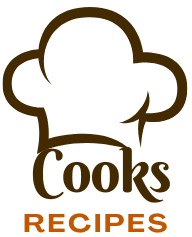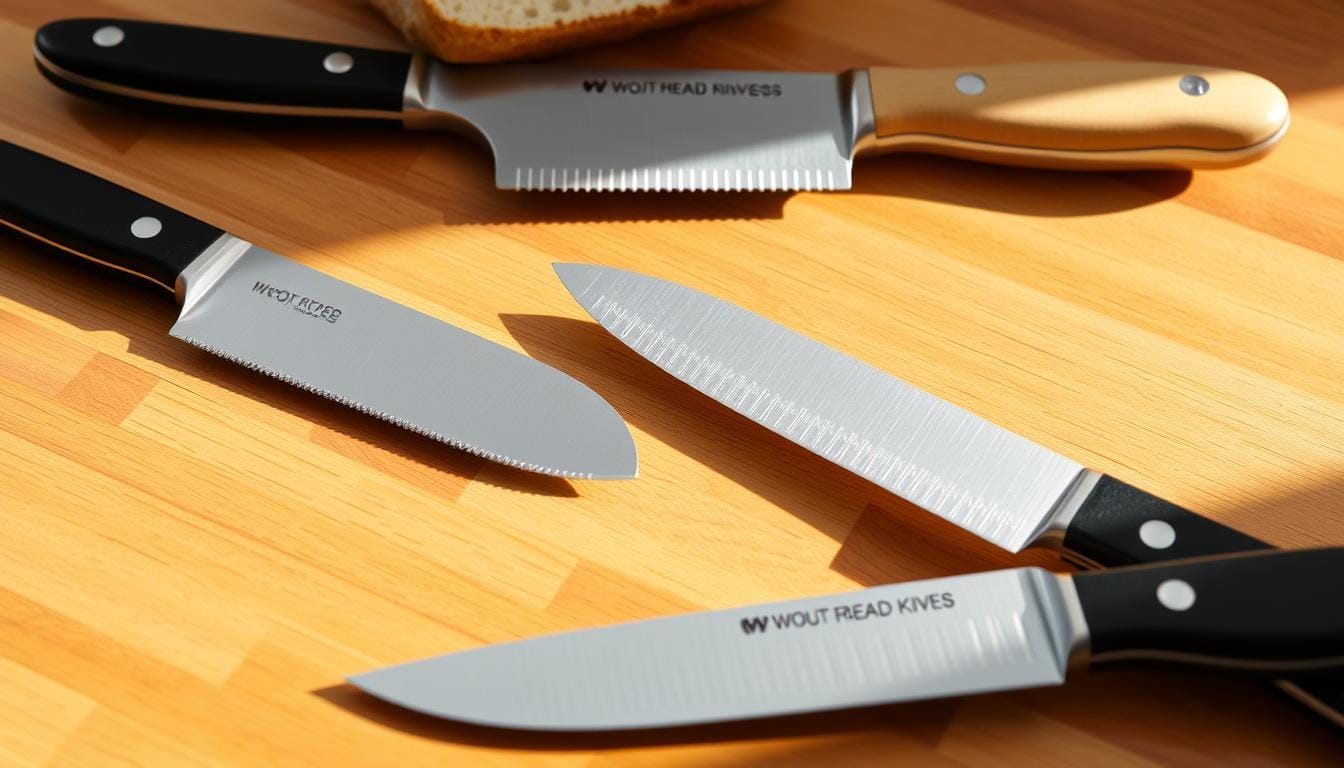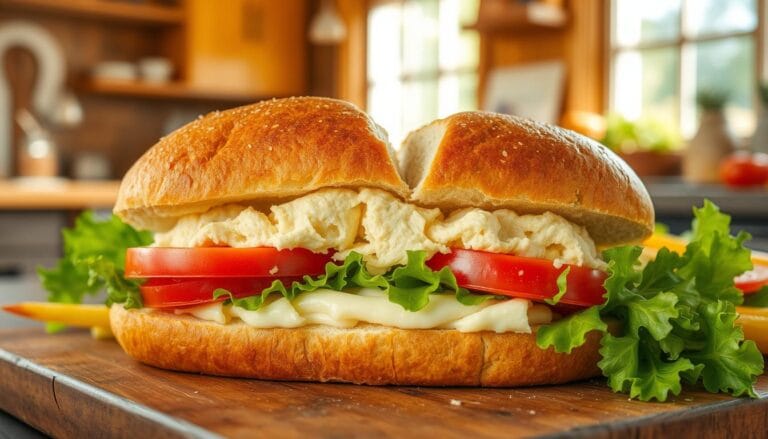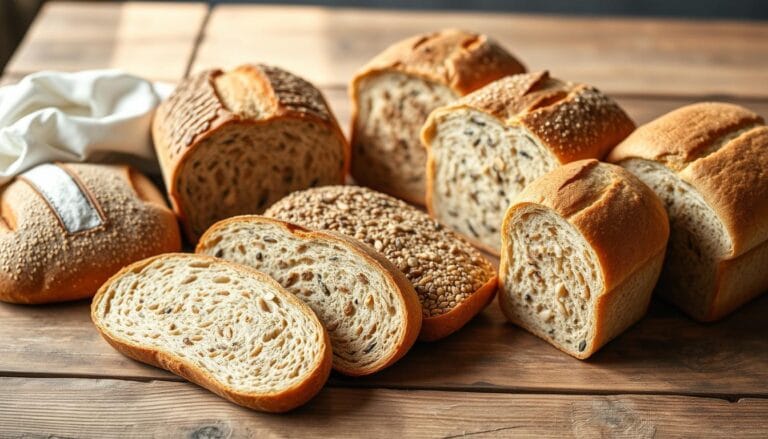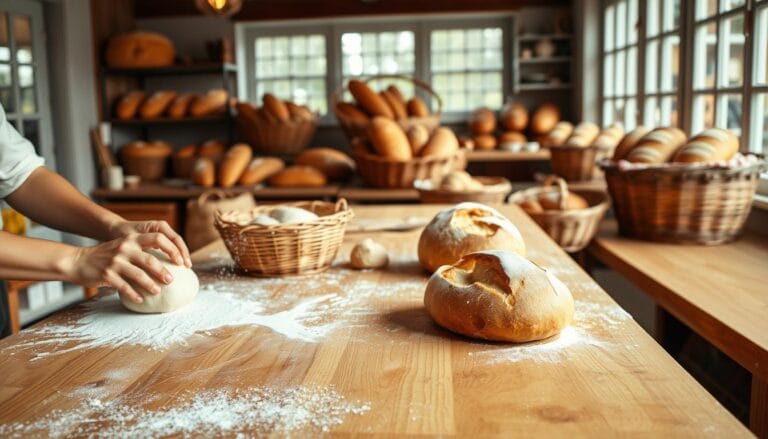Find the Perfect Bread Knife for Effortless Slicing
Every home cook has faced the frustration of crushing a beautiful loaf of bread. It’s that moment when your carefully baked bread falls apart. This is where a quality bread knife becomes your culinary savior.
Table of Contents
A professional serrated blade changes your slicing experience. It lets you cut through crusty exteriors with precision and grace. Whether you’re making a weekend breakfast or crafting the perfect sandwich, the right kitchen utensil makes all the difference.
Professional chefs and home bakers know not all bread knives are the same. Blade lengths range from 8 to 10.6 inches, and prices go from $38 to $440. Choosing the perfect slicing bread knife requires careful consideration.
This guide will help you choose a bread knife that will elevate your culinary skills. You’ll learn about serration patterns and top professional recommendations. You’ll discover how to make informed decisions that transform your kitchen experience.
Get ready to slice with confidence and precision – your bread deserves nothing less than a perfect cut.
Understanding Serrated Knives: Essential Features
Serrated blades are key in the kitchen, making cooking easier. They have unique edges that help cut through different textures smoothly. Whether you bake at home or work in a kitchen, knowing about serrated knives can improve your skills.
Serrated knives are very versatile. Their special edge lets them cut through tough foods like crusty bread and soft pastries. They can even cut through delicate tomatoes without damaging them.
Types of Serration Patterns
Serrated blades have different patterns for different cutting needs:
- Rounded serrations: Gentle cutting for softer foods
- Pointed serrations: Aggressive cutting for crusty breads
- Combination serrations: Versatile cutting across multiple food types
Blade Length Considerations
Choosing the right blade length is important. Most professional serrated knives are 8 to 10.5 inches long. This length gives you the best cutting leverage and control.
Handle Design and Ergonomics
The handle of a serrated knife is crucial for a good cutting experience. Look for handles that offer:
- Comfortable grip
- Balanced weight distribution
- Non-slip surfaces
- Material that withstands frequent use
Understanding these features helps you pick the right serrated knife. It will make your kitchen work better and meet your needs.
What Makes a Quality Bread Knife
Finding the perfect sharp knife for food preparation is key. It makes a bread knife go from good to great. Your baked goods need precise cutting to keep their shape and look.
When choosing a top-notch bread knife, several important factors come into play:
- Blade Material: High-carbon stainless steel is durable and keeps its edge well
- Serration Design: Fine teeth prevent tearing and make clean cuts
- Handle Ergonomics: A comfortable grip helps avoid hand fatigue during long prep times
Professional chefs and home bakers know a knife’s quality matters. Thin blades with consistent serration patterns make the best slices for all bread types.
“A quality bread knife transforms bread cutting from a chore to an art form.”
A good bread knife needs to cut with little pressure, be flexible, and slice through crusty outsides without squishing soft insides. It should weigh between 4.3 and 6.8 ounces, with a blade length of 9 to 11 inches.
Investing in a top bread knife means better precision, efficiency, and fun in food prep.
Top Professional Bread Knife Recommendations
Finding the right bread knife can change how you cut bread. The best knife is sharp, comfortable, and lasts long. We’ve looked at many options to find the perfect serrated knife for you.
Premium Selection: Mac Professional Series
The Mac Professional Series is a top choice for cutting bread. It has a 10.5-inch blade and sharp serrations. It’s known for:
- Lightweight design at 6.6 oz
- Exceptional sharpness
- Precision slicing
- Priced at $100
Mid-Range Option: Wüsthof Classic
The Wüsthof Classic is a great value. It has:
- 9-inch double-serrated blade
- Weight of 6.4 oz
- Reliable cutting
- Priced at $150
Budget-Friendly Choice: Mercer Culinary
The Mercer Culinary Millennia is perfect for those on a budget. It’s a great deal:
- 10-inch blade length
- Lightweight at 5.9 oz
- Exceptional price
- Priced between $16-$20
| Knife Brand | Length | Weight | Price |
|---|---|---|---|
| Mac Professional | 10.5 inches | 6.6 oz | $100 |
| Wüsthof Classic | 9 inches | 6.4 oz | $150 |
| Mercer Culinary | 10 inches | 5.9 oz | $16-$20 |
When picking a bread knife, think about your budget, cutting needs, and what you like. Each knife has its own benefits for different cutting styles.
The Importance of Blade Material and Construction
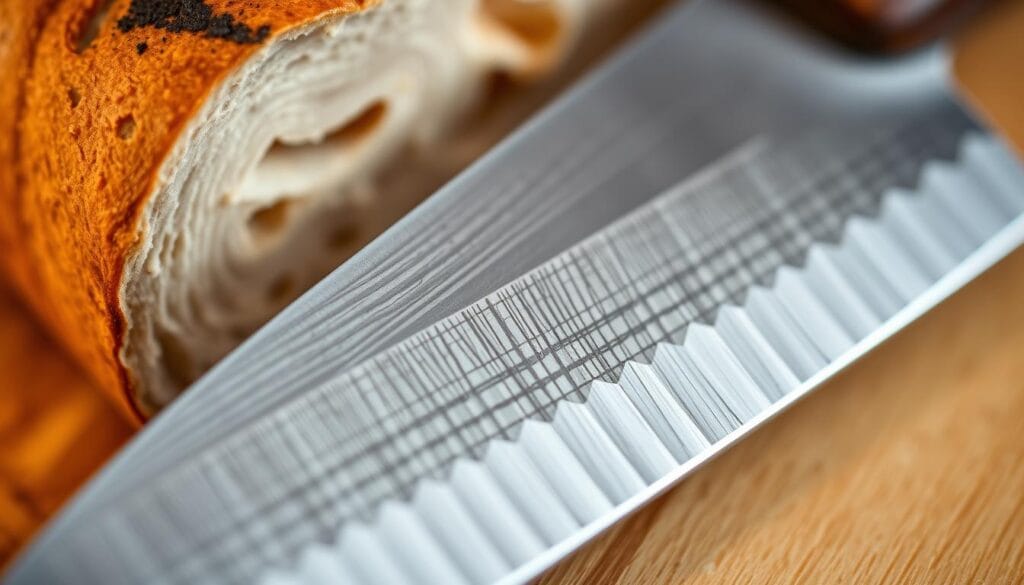
Choosing the right knife for your kitchen is key. High-carbon stainless steel is the top choice for bread knives. It’s durable and keeps its edge well, which chefs love.
Knife making involves several important steps:
- Hardness rating between 58-62 HRC on the Rockwell C scale
- Carbon content exceeding 0.5% for high-carbon classification
- Chromium content above 13% for optimal corrosion resistance
The quality of your serrated blade comes from careful metal work. Heat treatment is crucial. It turns raw metal into a sharp cutting tool through special processes.
“A knife is only as good as its materials and craftsmanship” – Professional Chef’s Wisdom
Top knives use special alloys for better performance. Vanadium helps keep the edge sharp, and molybdenum makes the knife tougher. These details make a big difference.
When buying a bread knife, look at these features. They ensure your knife will last for many years.
Choosing the Right Bread Knife for Your Needs
Finding the perfect bread knife is all about what you need in the kitchen. The right tool makes slicing bread easy. Knowing what you need helps you pick the best tool for your cooking style.
Different people need different bread knives. Let’s look at the best choices for different cooking situations:
Home Baker Requirements
Home bakers need a versatile knife. A 9-10 inch knife is usually the best choice. Look for:
- A comfortable handle
- A blade length of 8-10 inches
- A price between $20-$60
- A good serration pattern
Professional Kitchen Demands
Professional chefs need stronger tools. They look for:
- A longer blade, 10-11 inches
- High-carbon stainless steel
- An ergonomic handle
- Durability
- Sharp cutting
Occasional User Considerations
Those who bake less often should focus on cost and simplicity. Look for:
- Knives that are affordable, $16-$30
- A simple, comfortable design
- A sharp blade
- Easy to clean
The right bread knife is an investment in your cooking. Choose based on your kitchen needs and how often you bake.
Beyond Bread: Versatile Uses for Serrated Knives
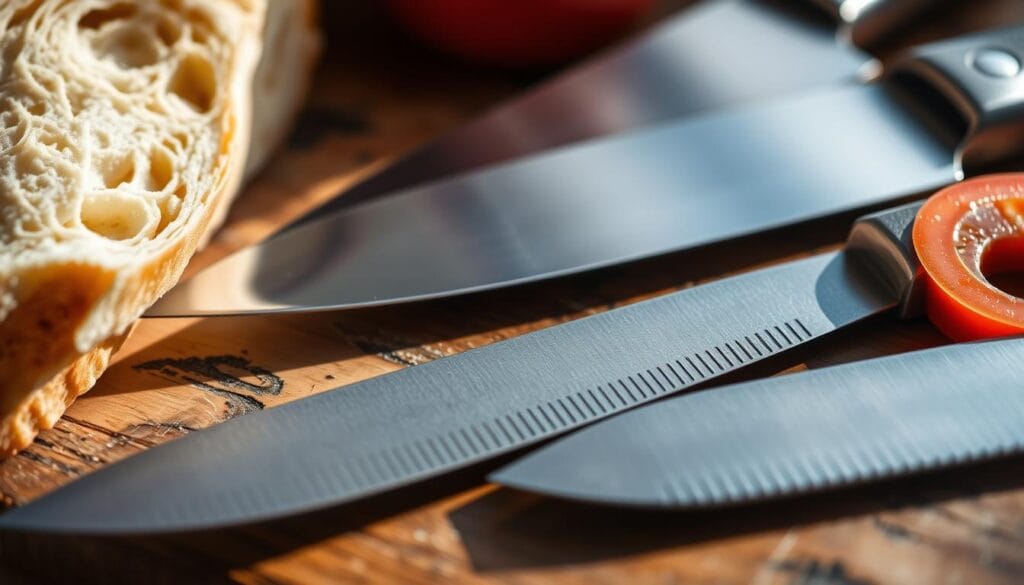
Your serrated blade is more than just for slicing bread. It’s a kitchen hero that can handle many tasks with ease. These knives are perfect for food preparation challenges.
Serrated knives are great for cutting through tough ingredients. Their special edges are perfect for several tasks:
- Slicing ripe tomatoes without crushing
- Cutting through tough-skinned fruits like pineapples
- Precise cuts on delicate pastries and cakes
- Slicing soft cheeses without sticking
- Cutting sushi rolls with clean edges
Professional chefs love the serrated blade for its versatility. From delicate fruit to crusty artisan bread, it makes clean cuts every time.
| Food Type | Serrated Knife Performance |
|---|---|
| Tomatoes | Cuts without crushing |
| Pineapples | Pierces tough skin easily |
| Cakes | Clean, precise slices |
| Soft Cheeses | Prevents sticking |
Whether you’re cooking at home or in a professional kitchen, a serrated knife is essential. It makes food preparation easier and more enjoyable. It’s a key tool for any kitchen.
Maintenance and Care Tips for Longevity
Keeping your bread knife in good shape is key to its performance and longevity. As a vital kitchen tool, proper care ensures your baking tools last for years.
Knife care is more than just cleaning. Professional chefs know that a well-kept bread knife is a valuable addition to your kitchen.
Proper Cleaning Techniques
Cleaning your bread knife right is important. Hand washing is the best way to keep your knives sharp:
- Use mild dish soap and warm water
- Clean it right after you use it
- Dry it with a soft cloth
- Stay away from dishwashers, which can harm the blade
“A dull knife is significantly more dangerous than a sharp one” – Knife Safety Experts
Smart Storage Solutions
It’s vital to protect your bread knife’s sharp edge. Here are some storage ideas:
- Knife blocks with individual slots
- Magnetic wall strips
- Blade guards for individual protection
Professional Sharpening Schedule
Serrated bread knives need special sharpening. Getting help from professionals keeps your knife sharp:
| Usage Level | Recommended Sharpening Frequency |
|---|---|
| Home Baker | Every 2-3 years |
| Professional Kitchen | Annually |
| Occasional User | Every 3-4 years |
Pro tip: Regular honing can make your knife last longer between sharpenings, keeping it in perfect shape.
Common Mistakes When Using a Bread Knife
Slicing bread might seem easy, but many people make mistakes. These errors can harm your knife and mess up your cooking. Knowing these mistakes can make you better at cutting bread and keep your kitchen tools safe.
- Applying too much pressure when cutting bread
- Using hard sawing motions that hurt the bread
- Trying to cut bread that’s too fresh or too old
- Cutting on the wrong surfaces
Studies show that 40% of knife accidents happen because of bad handling. Dull knives need more force, which can lead to accidents. It’s important to cut bread smoothly to keep it intact and avoid crushing it.
| Mistake | Potential Consequence | Recommended Solution |
|---|---|---|
| Cutting on hard surfaces | 30% less sharp knife edge | Use wooden or soft cutting boards |
| Improper knife storage | Higher risk of cuts | Use knife blocks or magnetic strips |
| Dishwasher cleaning | 70% more chance of knife damage | Hand wash and dry right away |
Professional chefs say to avoid these mistakes to keep your bread knife sharp. By using the right techniques, you’ll get better at cooking and protect your kitchen tools.
“A sharp knife is a safe knife” – Professional Chef’s Motto
Keeping your knife clean and handled right can make it last 50% longer. Spend time learning how to slice bread correctly to improve your cooking.
Conclusion
A good bread knife is more than a tool—it’s a key part of cooking. It turns torn baked goods into clean, precise slices. This shows off the beauty of artisan breads.
The right knife can do more than just slice. It can handle delicate cakes and tough squash too. This makes it a versatile tool in the kitchen.
When picking a knife, think about its length, serration, and build. Even professional-grade knives like the Mercer Culinary Millennia don’t have to be expensive. They offer durability and precision for many tasks.
Keeping your knife in good shape is important. Clean it regularly, store it carefully, and know when to get a new one. This ensures it works well for a long time.
Choosing the perfect bread knife is a personal choice. It depends on your cooking needs, budget, and comfort. Take your time to find a knife that fits your style and skills.
